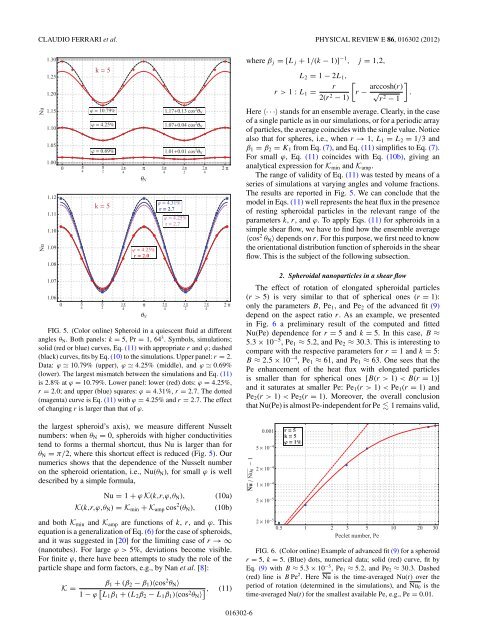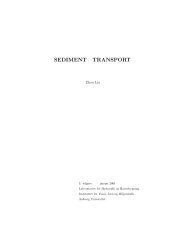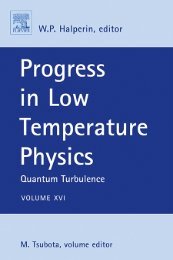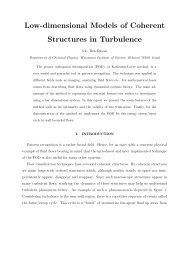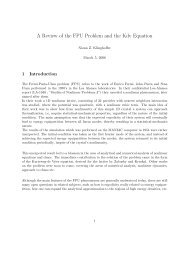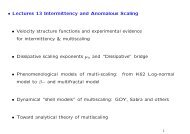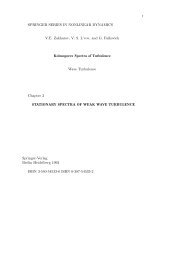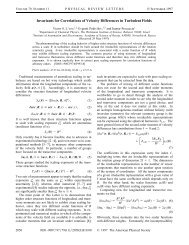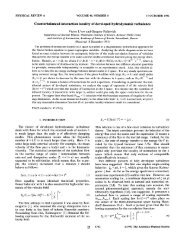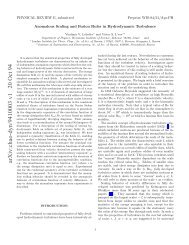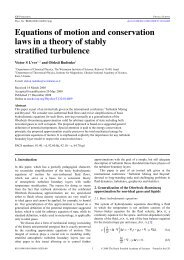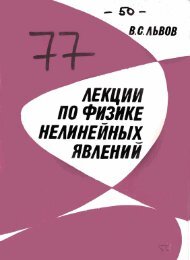Analytical modeling for heat transfer in sheared flows of nanofluids
Analytical modeling for heat transfer in sheared flows of nanofluids
Analytical modeling for heat transfer in sheared flows of nanofluids
You also want an ePaper? Increase the reach of your titles
YUMPU automatically turns print PDFs into web optimized ePapers that Google loves.
CLAUDIO FERRARI et al. PHYSICAL REVIEW E 86, 016302 (2012)<br />
Nu<br />
Nu<br />
1.30<br />
1.25<br />
1.20<br />
1.15<br />
1.10<br />
1.05<br />
1.00<br />
1.12<br />
1.11<br />
1.10<br />
1.09<br />
1.08<br />
1.07<br />
0<br />
1.06<br />
0<br />
π<br />
4<br />
π<br />
4<br />
k 5<br />
10.79 1.17 0.13 cos 2 θN<br />
4.25 1.07 0.04 cos 2 θN<br />
0.69 1.01 0.01 cos 2 θN<br />
π<br />
2<br />
k 5<br />
π<br />
2<br />
3 π<br />
4<br />
3 π<br />
4<br />
π<br />
θN<br />
4.25<br />
r 2.0<br />
π<br />
θN<br />
5 π<br />
4<br />
4.31<br />
r 2.7<br />
4.25<br />
r 2.7<br />
FIG. 5. (Color onl<strong>in</strong>e) Spheroid <strong>in</strong> a quiescent fluid at different<br />
angles θN. Bothpanels:k = 5, Pr = 1, 64 3 . Symbols, simulations;<br />
solid (red or blue) curves, Eq. (11) with appropriate r and ϕ; dashed<br />
(black) curves, fits by Eq. (10) to the simulations. Upper panel: r = 2.<br />
Data: ϕ 10.79% (upper), ϕ 4.25% (middle), and ϕ 0.69%<br />
(lower). The largest mismatch between the simulations and Eq. (11)<br />
is 2.8% at ϕ = 10.79%. Lower panel: lower (red) dots: ϕ = 4.25%,<br />
r = 2.0; and upper (blue) squares: ϕ = 4.31%, r = 2.7. The dotted<br />
(magenta) curve is Eq. (11) with ϕ = 4.25% and r = 2.7. The effect<br />
<strong>of</strong> chang<strong>in</strong>g r is larger than that <strong>of</strong> ϕ.<br />
the largest spheroid’s axis), we measure different Nusselt<br />
numbers: when θN = 0, spheroids with higher conductivities<br />
tend to <strong>for</strong>ms a thermal shortcut, thus Nu is larger than <strong>for</strong><br />
θN = π/2, where this shortcut effect is reduced (Fig. 5). Our<br />
numerics shows that the dependence <strong>of</strong> the Nusselt number<br />
on the spheroid orientation, i.e., Nu(θN), <strong>for</strong> small ϕ is well<br />
described by a simple <strong>for</strong>mula,<br />
5 π<br />
4<br />
3 π<br />
2<br />
3 π<br />
2<br />
7 π<br />
4<br />
7 π<br />
4<br />
2 π<br />
2 π<br />
Nu = 1 + ϕ K(k,r,ϕ,θN), (10a)<br />
K(k,r,ϕ,θN) = Km<strong>in</strong> + Kamp cos 2 (θN), (10b)<br />
and both Km<strong>in</strong> and Kamp are functions <strong>of</strong> k, r, and ϕ. This<br />
equation is a generalization <strong>of</strong> Eq. (6) <strong>for</strong> the case <strong>of</strong> spheroids,<br />
and it was suggested <strong>in</strong> [20] <strong>for</strong> the limit<strong>in</strong>g case <strong>of</strong> r →∞<br />
(nanotubes). For large ϕ>5%, deviations become visible.<br />
For f<strong>in</strong>ite ϕ, there have been attempts to study the role <strong>of</strong> the<br />
particle shape and <strong>for</strong>m factors, e.g., by Nan et al. [8]:<br />
β1 + (β2 − β1)〈cos<br />
K =<br />
2θN〉 1 − ϕ L1β1 + (L2β2 − L1β1)〈cos2 , (11)<br />
θN〉<br />
where βj = [Lj + 1/(k − 1)] −1 , j = 1,2,<br />
r>1:L1 =<br />
L2 = 1 − 2L1,<br />
r<br />
2(r 2 − 1)<br />
<br />
r − arccosh(r)<br />
<br />
√ .<br />
r2 − 1<br />
Here 〈···〉stands <strong>for</strong> an ensemble average. Clearly, <strong>in</strong> the case<br />
<strong>of</strong> a s<strong>in</strong>gle particle as <strong>in</strong> our simulations, or <strong>for</strong> a periodic array<br />
<strong>of</strong> particles, the average co<strong>in</strong>cides with the s<strong>in</strong>gle value. Notice<br />
also that <strong>for</strong> spheres, i.e., when r → 1, L1 = L2 = 1/3 and<br />
β1 = β2 = K1 from Eq. (7), and Eq. (11) simplifies to Eq. (7).<br />
For small ϕ, Eq.(11) co<strong>in</strong>cides with Eq. (10b), giv<strong>in</strong>gan<br />
analytical expression <strong>for</strong> Km<strong>in</strong> and Kamp.<br />
The range <strong>of</strong> validity <strong>of</strong> Eq. (11) was tested by means <strong>of</strong> a<br />
series <strong>of</strong> simulations at vary<strong>in</strong>g angles and volume fractions.<br />
The results are reported <strong>in</strong> Fig. 5. We can conclude that the<br />
model <strong>in</strong> Eqs. (11) well represents the <strong>heat</strong> flux <strong>in</strong> the presence<br />
<strong>of</strong> rest<strong>in</strong>g spheroidal particles <strong>in</strong> the relevant range <strong>of</strong> the<br />
parameters k, r, and ϕ. To apply Eqs. (11) <strong>for</strong> spheroids <strong>in</strong> a<br />
simple shear flow, we have to f<strong>in</strong>d how the ensemble average<br />
〈cos 2 θN〉 depends on r. For this purpose, we first need to know<br />
the orientational distribution function <strong>of</strong> spheroids <strong>in</strong> the shear<br />
flow. This is the subject <strong>of</strong> the follow<strong>in</strong>g subsection.<br />
2. Spheroidal nanoparticles <strong>in</strong> a shear flow<br />
The effect <strong>of</strong> rotation <strong>of</strong> elongated spheroidal particles<br />
(r >5) is very similar to that <strong>of</strong> spherical ones (r = 1):<br />
only the parameters B, Pe1, and Pe2 <strong>of</strong> the advanced fit (9)<br />
depend on the aspect ratio r. As an example, we presented<br />
<strong>in</strong> Fig. 6 a prelim<strong>in</strong>ary result <strong>of</strong> the computed and fitted<br />
Nu(Pe) dependence <strong>for</strong> r = 5 and k = 5. In this case, B ≈<br />
5.3 × 10−5 ,Pe1≈ 5.2, and Pe2 ≈ 30.3. This is <strong>in</strong>terest<strong>in</strong>g to<br />
compare with the respective parameters <strong>for</strong> r = 1 and k = 5:<br />
B ≈ 2.5 × 10−4 ,Pe1≈61, and Pe1 ≈ 63. One sees that the<br />
Pe enhancement <strong>of</strong> the <strong>heat</strong> flux with elongated particles<br />
is smaller than <strong>for</strong> spherical ones [B(r >1) 1) < Pe1(r = 1) and<br />
Pe2(r >1) < Pe2(r = 1). Moreover, the overall conclusion<br />
that Nu(Pe) is almost Pe-<strong>in</strong>dependent <strong>for</strong> Pe 1 rema<strong>in</strong>s valid,<br />
Nu Nu 0 1<br />
016302-6<br />
0.001<br />
5 10 4<br />
2 10 4<br />
1 10 4<br />
5 10 5<br />
2 10 5<br />
r 5<br />
k 5<br />
1<br />
0.5 1 2 3 5 10 20 30<br />
Peclet number, Pe<br />
FIG. 6. (Color onl<strong>in</strong>e) Example <strong>of</strong> advanced fit (9) <strong>for</strong> a spheroid<br />
r = 5, k = 5. (Blue) dots, numerical data; solid (red) curve, fit by<br />
Eq. (9) with B ≈ 5.3 × 10 −5 ,Pe1 ≈ 5.2, and Pe2 ≈ 30.3. Dashed<br />
(red) l<strong>in</strong>e is B Pe 2 . Here Nu is the time-averaged Nu(t) over the<br />
period <strong>of</strong> rotation (determ<strong>in</strong>ed <strong>in</strong> the simulations), and Nu0 is the<br />
time-averaged Nu(t) <strong>for</strong> the smallest available Pe, e.g., Pe = 0.01.


